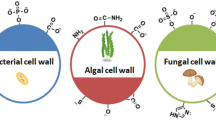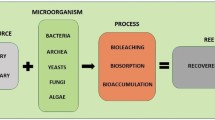Abstract
In recent years, rare earth elements (REEs) have been widely used in various modern technological devices and the global demand for REE has been increasing. The increased demand for REEs has led to environmental exposure or water pollution from rare earth metal mines and various commercial products. Therefore, the development of a safe technology for the separation and adsorption of REEs is very important from the perspective of green chemistry and environmental pollution. In this review, the application and mechanisms of microorganisms for the removal and extraction of REEs from aqueous solutions are described. In addition, the advantages in using microorganisms for REE adsorption and future studies on this topic are discussed.



Similar content being viewed by others
References
Anderson CR, Pederson K (2003) In situ growth of Gallionella biofilms and partitioning of lanthanides and actinides between biological material and ferric oxyhydroxides. Geobiol 1:169–178
Andres Y, Texier AC, Cloirec PL (2003) Rare earth elements removal by microbial biosorption: a review. Environ Technol 24:1367–1375
Andrianov AV, Savel’eva OA, Bauer E, Staunton JB (2011) Squeezing the crystalline lattice of the heavy rare earth metals to change their magnetic order: experiment and ab initio theory. Phys Rev B 84:132401
Babel S, Kurniawan TA (2003) Low-cost adsorbents for heavy metals uptake from contaminated water: a review. J Hazard Mater 97:219–243
Basu A, Chakrabarty K, Chatterjee GC (1982) Neurotoxicity of lanthanum chloride in newborn chicks. Toxicol Lett 14:21–25
Buchmeiser MR, Tessadri R, Seebar G, Bonn GK (1998) Selective extraction of rare earth elements from rocks using a high-capacity cis-1,4-butanedioic acid functionalized resin. Anal Chem 70:2130–2136
Chen Y, Zhu B, Wu D, Wang Q, Yang Y, Ye W, Guo J (2012) Eu(III) adsorption using di(2-thylhexly)phosphoric acid-immobilized magnetic GMZ bentonite. Chem Eng J 181–182:387–396
Demirbas A (2008) Heavy metal adsorption onto agro-based waste materials: a review. J Hazard Mater 157:220–229
Du X, Graedel TE (2011) Global in-use-stocks of the rare earth elements: a first estimate. Environ Sci Technol 45:4096–4101
Fontana D, Pietrelli L (2009) Separation of middle rare earths by solvent extraction using 2-ethylhexylphosphonic acid mono-3-ethylhexyl ester as an extractant. J Rare Earths 27:830–833
Fortin D, Langley S (2005) Formation and occurrence of biogenic iron-rich minerals. Earth-Sci Re 72:1–19
Ghimire KN, Inoue K, Yamaguchi H, Makino K, Miyajima T (2003) Adsorptive separation of arsenate and arsenite anions from aqueous medium by using orange waste. Water Res 37:4945–4953
Haferburg G, Merten D, Buchel G, Kothe E (2007) Biosorption of metal and salt tolerant microbial isolates from a former uranium mining area. Their impact on changes in rare earth element patterns in acid mine drainage. J Basic Microbiol 47:474–484
Hirano S, Suzuki KT (1996) Exposure, metabolism, and toxicity of rare earths and related compounds. Environ Health Perspect 104(Suppl 1):85–95
Kato Y, Fujinaga K, Nakamura K, Takaya Y, Kitamura K, Ohta J, Toda R, Nakashima T, Iwamori H (2011) Deep-sea mud in the Pacific Ocean as a potential resource for rare-earth elements. Nature Geosci 4:535–539
Klaus-Joerger T, Joerger R, Olsson E, Granqvist C-G (2001) Bacteria as workers in the living factory: metal-accumulating bacteria and their potential for materials science. Trends Biotechnol 19:15–20
Kuroda K, Ueda M (2010) Engineering of microorganisms towards recovery of rare metal ions. Appl Microbiol Biotechnol 87:53–60
Lazarevic V, Pooley HM, Mauël C, Karamata D (2002) Teichoic and teichuronic acids from Gram-positive bacteria. In: Vandamme EJ, DeBaets S, Steinbüchel A (eds) Biopolymers, vol. 5, polysaccharides I: polysaccharides from prokaryotes. Wiley, Weinheim, pp 465–492
Markai S, Andres Y, Montavon G, Grambow B (2003) Study of the interaction between europium(III) and Bacillus subtilis fixation sites, biosorption modeling and reversibility. J Colloid Interf Sci 262:351–361
Merroun ML, Ben Omar N, Gonzalez-Munoz MT, Arias JM (1998) Myxococcus xanthus biomass as biosorbent for lead. J Appl Microbiol 84:63–67
Merroun ML, Chekroun KL, Arias JM, González-Munoz MT (2003) Lanthanum fixation by Myxococcus xanthus: cellular location and extracellular polysaccharide observation. Chemosphere 52:113–120
Miyawaki R, Nakai I (1993) Crystal structures of rare earth minerals. In: Gshneidner KA, Eyring L (ed) Handbook on the physics and chemistry of rare earths. Elsevier 16:230–257
Molander GA, Romero JAC (2002) Lanthanocene catalysts in selective organic synthesis. Chem Rev 102:2161–2185
Moriwaki H, Kitajima S, Kurashima M, Hagiwara A, Haraguchi K, Shirai K, Kanekatsu R, Kiguchi K (2009) Utilization of silkworm cocoon waste as a sorbent for the removal of oil from water. J Hazard Mater 165:266–270
Moriwaki H, Koide R, Yoshikawa R, Warabino Y, Yamamoto H (2012) Adsorption of rare earth ions onto the cell walls of wild type and lipoteichoic acid-defective strains of Bacillus subtilis. Appl Microbiol Biotech. doi:10.1007/s00253-012-4200-3
Neuhaus FC, Baddiley J (2003) A continuum of anionic charge: structures and functions of D-alanyl-teichoic acids in gram-positive bacteria. Microbiol Mol Biol Rev 67:686
Ngwenya BT, Mosselmans JFW, Megennis M, Atkinson KD (2009) Macroscopic and spectroscopic analysis of lanthanide adsorption to bacterial cells. Geochim Cosmochim Acta 67:3299–3312
Ozaki T, Gillow JB, Francis AJ, Kimura T, Ohnuki T, Yoshida Z (2002a) Association of Eu(III) and Cm(III) with Bacillus subtilis and Halobacterium salinarum. J Nucl Sci Technol 3(Suppl):950–953
Ozaki T, Arisaka M, Kimura T, Francis AJ (2002b) Empirical method for prediction of the coordination environment of Eu(III) by time-resolved laser-induced fluorescence spectroscopy. Anal Bioanal Chem 374:1101–1104
Ozaki T, Kimura T, Ohnuki T, Francis AJ (2005) Associations of Eu(III) with gram-negative bacteria, Alcaligenes faecalis, Shewanella putrefaciens, and Paracoccus denitrificans. J Nucl Radiochem Sci 6:73–76
Ozaki T, Suzuki Y, Nankawa T, Yoshida T, Ohnuki T, Kimura T, Francis AJ (2006) Interactions of rare earth elements with bacteria and organic ligands. J Alloys Compd 408–412:1334–1338
Pałasz A, Czekaj P (2000) Toxicological and cytophysiological aspects of lanthanides action. Acta Biochim Polonica 47:1107–1114
Reichmann NT, Gründling A (2011) Location, synthesis and function of glycolipids and polyglycerolphosphate lipoteichoic acid in Gram-positive bacteria of the phylum Firmicutes. FEBS Microbiol Lett 319:97–105
Rudd T, Sterritt RM, Lester JN (1984) Formation and conditional stability constants of complexes formed between heavy metals and bacterial extracellular polymers. Water Res 18:379–384
Schirner K, Marles-Wright J, Lewis RJ, Errington J (2009) Distinct and essential morphogenic functions for wall- and lipoteichoic acids in Bacillus subtilis. EMBO J 8:830–842
Senthilkumaar S, Krishna SK, Kalaamani P, Subburamaan CV, G.-Subramaniam N (2010) Adsorption of organophosphorous pesticide from aqueous solution using “waste” Jute fiber carbon. Modern Appl Sci 4:67–83
Shan X-Q, Lian J, Wen B (2002) Effect of organic acids on adsorption and desorption of rare earth elements. Chemosphere 47:701–710
Sponza DT (2002) Extracellular polymer substances physicochemical properties of flocs in steady and unsteady-state activated sludge systems. Process Biol 37:983–998
Sud D, Mahajan G, Kaur MP (2008) Agricultural waste material as potential adsorbent for sequestering heavy metal ions from aqueous solutions—a review. Biores Technol 99:6017–6027
Sun X, Luo H, Dai S (2012) Solvent extraction of rare earth ions based on functionalized ionic liquids. Talanta 90:132–137
Suzuki Y, Nankawa T, Yoshida T, Ozaki T, Ohnuki T, Francis AJ, Tsushima S, Enokida Y, Yamamoto I (2005) Sorption of Eu(III) on Pseudomonas fluorescens in the presence of citric acid. J Nucl Radiochem Sci 6:91–93
Takahashi Y, Châtellier X, Hattori KH, Kato K, Fortin D (2005) Adsorption of rare earth elements onto bacteria cell walls and its implication for REE sorption onto natural microbial mats. Chem Geol 219:53–67
Takahashi Y, Hirata T, Shimizu H, Ozaki T, Fortin D (2007) A rare earth element signature of bacteria in natural waters? Chem Geol 244:569–583
Takahashi Y, Yamamoto M, Yamamoto Y, Tanaka K (2010) EXAFS study on the cause of enrichment of heavy REE on bacterial cell surfaces. Geochim Cosmochim Acta 74:5443–5462
Tanaka K, Tani Y, Takahashi Y, Tanimizu M, Suzuki Y, Kozai N, Ohnuki T (2010) A specific Ce oxidation process during sorption of rare earth elements on biogenic Mn oxide produced by Acremonium sp. Strain KR21-2. Geochim Cosmochim Acta 74:5463–5477
Tani Y, Miyata N, Iwahori K, Soma M, Tokuda S, Seyama H, Theng BKG (2003) Biogeochemistry of manganese oxide coatings on pebble surfaces in the Kikukawa River system, Shizuoka. Japan Appl Geochem 18:1541–1554
Tani Y, Miyata N, Ohashi M, Ohnuki T, Seyama H, Iwahori K, Soma M (2004) Interaction of inorganic arsenic with biogenic manganese oxide produced by a Mn-oxidizing fungus, Strain KR21-2. Environ Sci Technol 38:6618–6624
Texier AC, Andrès Y, Illemassen L, Cloirec PL (2000) Characterization of lanthanide ions binding sites in the cell wall of Pseudomonas aeruginosa. Environ Sci Technol 34:610–615
Tong SL, Zhu WZ, Gao ZH, Meng YX, Peng RL, Lu GC (2005) Distribution characteristics of rare earth elements in children’s scalp hair from a rare earths mining area in Southern China. J Envoron Sci Health A 39:2517–2532
Tsuruta T (2006) Selective accumulation of light or heavy rare earth elements using gram-positive bacteria. Colloids Surf B 52:117–122
Wörmann ME, Corrigan RM, Simpson PJ, Matthews SJ, Gründling A (2011) Enzymatic activities and functional interdependencies of Bacillus subtilis lipoteichoic acid synthesis enzymes. Mol Microbiol 79:566–583
Wu Y, Li T, Yang L (2012) Mechanisms of removing pollutants from aqueous solutions by microorganisms and their aggregates: a review. Bioresour Technol 107:10–18
Yoshida T, Ozaki T, Ohnuki T, Francis AJ (2004) Adsorption of rare earth elements by γ-Al2O3 and Pseudomonas fluorescens cells in the presence of desferrioxamine B: implication of siderophores for the Ce anomaly. Chem Geol 212:239–246
Zahir MH, Masuda Y (1997) Extractive separation of trivalent lanthanide metals with a combination of Di(2-ethylhexyl)phosphoric acid and 1,10-phenanthroline. Talanta 44:365–371
Acknowledgments
A part of this work was supported by Grants-in-Aid for Scientific Research (C; 19580085 and 23580107) and grants from the Kurata Memorial Hitachi Science and Technology Foundation, the Nagase Science and Technology Foundation, the Research Foundation for the Electrotechnology of Chubu, and Institute for Fermentation, Osaka to H.Y.
Author information
Authors and Affiliations
Corresponding author
Rights and permissions
About this article
Cite this article
Moriwaki, H., Yamamoto, H. Interactions of microorganisms with rare earth ions and their utilization for separation and environmental technology. Appl Microbiol Biotechnol 97, 1–8 (2013). https://doi.org/10.1007/s00253-012-4519-9
Received:
Revised:
Accepted:
Published:
Issue Date:
DOI: https://doi.org/10.1007/s00253-012-4519-9




